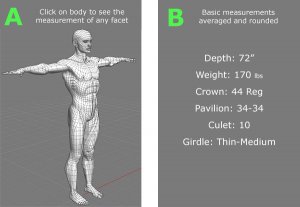Kaleigh
Super_Ideal_Rock
- Joined
- Nov 18, 2004
- Messages
- 29,571
I agree 100%. AGS wasn't a lab I knew about until PS. I don't see AGS0 stones around here, not to say they aren't avaliable, you have to ask for them. B&M's don't carry them as a norm. GIA mostly. My preference is for AGS, and buy online to get them. HRD does have an uphill battle to rival the status of AGS and GIA. Time will tell, I just don't see it happening.Date: 5/24/2008 12:12:49 AM
Author: Allison D.
This is true.......but who influences customer demand? Trusted dealers.......still.Date: 5/22/2008 12:27:53 PM
Author: John Pollard
Good example of an aggressive marketing campaign. I think you're right; targeting the trade is obviously an important step but consumer demand is what drives change.Date: 5/21/2008 10:12:42 PM
Author: Modified Brilliant
GCAL has been aggressively marketing their reports at every trade show and and seem to show up
at every industry sponsored event. They are producing a very comprehensive report but still lack consumer
recognition. Money spent on advertising and marketing doesn't always spell immediate success.
What does it take to instill confidence in the consumer with regard to diamond grading reports?
What methods will the consumer use to sort it all out?
How will 'Joe or Josephine Average Consumer' be able to determine an accurate report from a not so accurate report?
And who will enforce standards and accuracy?
Just wonderin'
Jeff Averbook,GG
Graduate Gemologist since 1986
www.metrojewelryappraisers.com
The thing that's always plagued the jewelry industry is lack of transparency. Diamonds didn't become the standard for engagement stones until the late 1930s DeBeers campaign. The campaign drove interest in the product, but I'd imagine consumers then felt much as consumers often still do today....confounded at how to feel confident in their purchase judgment without product knowledge.
When GIA began issuing diamond grading reports in 1955, I'd guess that must have been an epiphany moment for dealers. GIA reeked of credibility and expertise; in the 1940s, the U.S. government recognized them as a learning/research center and they began conferring GG diplomas.
I'd imagine the advent of these reports gave jewelers a way to neutralize the transparency/trust problem and build consumer confidence. Armed with printed expert opinions that endorsed dealers' professional recommendations on stones, it had to make closing sales easier. It makes sense that dealers would evangelize GIA's position as THE authority and gold-standard, helping GIA gain consumer recognition and acceptance.
Following labs have a harder road to hoe now because they face a formidable, entrenched incumbent in GIA. To win over dealers, they would have to provide something GIA didn't while meeting the existing standards bar set by GIA.
The introduction of AGSL grading reports in 1996 provided that platform. Their grading reports rivaled the standards of GIA and provided something GIA didn't....cut grade. I'm sure it also helps that AGS and GIA share a common founder, so AGS can wear that same badge of credibility through origin.
Dealers who specialize in fine make stones have been won over by AGS, but evangelization to consumers has been a bit more challenging because not all consumers care about the 'creme de la creme'. Without education, people can't appreciate the distinction and appeal of a fine make stone, and many people simply aren't interested enough to invest their time into learning. Their goal is just to make a decent purchase and be done with it.
The cut-grade distinction can be become a double-edged sword, though, because consumers are conditioned to want what they THINK is the best. If the label says 'very good' or 'good' instead of excellent or ideal, it's not as desirable. Hence, AGS's paper is only coveted if it bears the ultimate AGS0 label, so they aren't likely to become a household name akin to GIA unless GIA's introduction of the cut-grade has a similar effect on their reports.
One that thing has helped AGS is the internet. People have an easier time researching now, but I think they still rely on trusted trade members/dealers to help influence their preferences. We see it very clearly here on PS; the community here is largely influenced by trusted opinions from predominantly fine-make dealers who share their knowledge. That, in turn, influences consumer preference.
Ultimately, learned expert opinions still influence consumers, so unless HRD can bring something innovative to the table while rivalling existing AGS/GIA standards, it will be an uphill battle to establish any type of market acceptance in my opinion.











300x240.png)